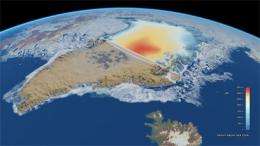Ice mission shows precise changes in Arctic sea-ice thickness

Scientists have produced the first map which shows the changes in the thickness of Arctic sea ice through the entire winter season. The map is the most accurate and extensive yet.
It was created using data from the European Space Agency's CryoSat-2 satellite and covers a huge swathe of the Arctic, right up to 88 degrees north – closer to the North Pole than any other satellite can reach.
CryoSat-2 was launched just two years ago to monitor changes in the thickness and shape of ice in both the Arctic and Antarctica.
The results were presented at London's Royal Society today.
These latest results demonstrate that data from the satellite can now be used to estimate the volume of ice in the Arctic. This figure is essential for understanding long-term changes in the region sea ice.
"CryoSat-2 is now able to generate estimates of sea-ice volume in the Arctic," says Dr. Seymour Laxon, director of the Centre for Polar Observation and Modelling (CPOM) at University College London, a member of the research team.
Laxon and the CPOM team behind this latest map produced a similar map in June 2011, based on just two months' of data, from January and February 2011. The results announced today use data from October 2010 right up to March 2011.
"While last year's map showed clear agreement with data gathered from aircraft, the data we used was uncalibrated. The new map uses calibrated data, which means it's much more accurate," explains Laxon.
"We're confident that the thickness values we've calculated are correct to the nearest 10 to 20cm," he adds.
Laxon and his colleagues calibrated data from CryoSat-2 against detailed in-situ measurements of sea-ice thickness taken using moorings placed in the Beaufort Sea by NASA. Data is also calibrated against measurements taken from aircraft during a campaign in the Arctic last summer.
This is the first map of its kind to be generated using data from a gadget called a radar altimeter, which fires pulses of microwave energy at the ice.
Researchers at CPOM calculate the thickness of the ice by comparing how long it takes for the echoes to return from the top of ice floes and from the water in cracks in the ice, called leads. The aim is to measure the freeboard - the part of the ice that sits above the waterline.
As well producing the map of Arctic sea-ice, researchers led by Professor Andrew Shepherd from the University of Leeds produced a digital elevation model of Greenland. The map is based on a year's worth of data from CryoSat-2.
Provided by PlanetEarth Online
This story is republished courtesy of Planet Earth online, a free, companion website to the award-winning magazine Planet Earth published and funded by the Natural Environment Research Council (NERC).




















